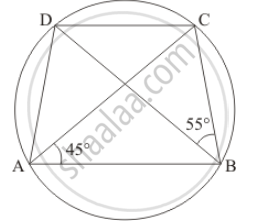Advertisements
Advertisements
प्रश्न
If a line is drawn parallel to the base of an isosceles triangle to intersect its equal sides, prove that the quadrilateral so formed is cyclic.
उत्तर
Given: ΔABC is an isosceles triangle such that AB = AC and also DE || BC.
To prove: Quadrilateral BCDE is a cyclic quadrilateral.
Construction: Draw a circle passes through the points B, C, D and E.
Proof: In ΔABC, AB = AC ...[Equal sides of an isosceles triangle]
⇒ ∠ACB = ∠ABC ...(i)
Since, DE || BC ...[Angles opposite to the equal sides are equal]
⇒ ∠ADE = ∠ACB [Corresponding angles] ...(ii)
On adding both sides by ∠EDC in equation (ii), we get
∠ADE + ∠EDC = ∠ACB + ∠EDC
⇒ 180° = ∠ACB + ∠EDC ...[∠ADE and ∠EDC from linear pair axiom]
⇒ ∠EDC + ∠ABC = 180° ...[From equation (i)]
Hence, BCDE is a cyclic quadrilateral, because sum of the opposite angles is 180°.
APPEARS IN
संबंधित प्रश्न
If diagonals of a cyclic quadrilateral are diameters of the circle through the vertices of the quadrilateral, prove that it is a rectangle.
Two circles intersect at two points B and C. Through B, two line segments ABD and PBQ are drawn to intersect the circles at A, D and P, Q respectively (see the given figure). Prove that ∠ACP = ∠QCD.

Prove that the line of centres of two intersecting circles subtends equal angles at the two points of intersection.
Two congruent circles intersect each other at points A and B. Through A any line segment PAQ is drawn so that P, Q lie on the two circles. Prove that BP = BQ.
Two chords AB and CD of lengths 5 cm 11cm respectively of a circle are parallel to each other and are on opposite sides of its centre. If the distance between AB and CD is 6 cm, find the radius of the circle.
In a cyclic quadrilateral ABCD, if ∠A − ∠C = 60°, prove that the smaller of two is 60°
ABCD is a cyclic trapezium with AD || BC. If ∠B = 70°, determine other three angles of the trapezium.
In the given figure, ABCD is a cyclic quadrilateral in which AC and BD are its diagonals. If ∠DBC = 55° and ∠BAC = 45°, find ∠BCD.
In the figure, ▢ABCD is a cyclic quadrilateral. If m(arc ABC) = 230°, then find ∠ABC, ∠CDA, ∠CBE.

If a pair of opposite sides of a cyclic quadrilateral are equal, prove that its diagonals are also equal.
